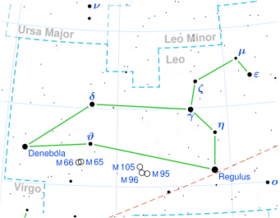Astronomy:Nu Leonis
| Observation data Epoch J2000.0 Equinox (celestial coordinates) | |
|---|---|
| Constellation | Leo |
| Right ascension | 09h 58m 13.37557s[1] |
| Declination | +12° 26′ 41.2865″[1] |
| Apparent magnitude (V) | 5.15[2] |
| Characteristics | |
| Spectral type | B6 IV[3] |
| U−B color index | −0.13[2] |
| B−V color index | −0.04[2] |
| Astrometry | |
| Radial velocity (Rv) | +14.4[4] km/s |
| Proper motion (μ) | RA: −25.66[1] mas/yr Dec.: −15.56[1] mas/yr |
| Parallax (π) | 6.53 ± 0.24[1] mas |
| Distance | 500 ± 20 ly (153 ± 6 pc) |
| Absolute magnitude (MV) | −0.66[5] |
| Orbit[6] | |
| Period (P) | 137.2978 d |
| Eccentricity (e) | 0.7 |
| Longitude of the node (Ω) | 293.7° |
| Periastron epoch (T) | 2419815.9 JD |
| Semi-amplitude (K1) (primary) | 20 km/s |
| Details | |
| Mass | 3.37±0.05[7] M☉ |
| Radius | 2.3[8] R☉ |
| Luminosity | 244[7] L☉ |
| Temperature | 9,552[9] K |
| Rotational velocity (v sin i) | 100[7] km/s |
| Other designations | |
| Database references | |
| SIMBAD | data |
ν Leonis, Latinised as Nu Leonis, is a binary star system in the zodiac constellation of Leo. It is faintly visible to the naked eye with an apparent visual magnitude of 5.15;[2] parallax measurements[1] indicate it is around 500 light years away. At this distance, the visual extinction from interstellar dust is 0.33 magnitudes.[11]
It is 0.05 degree north of the ecliptic, so it can be occulted by the moon or planets.
This is a single-lined spectroscopic binary system with an orbital period of 137.3 days and an eccentricity of 0.7.[6] The primary component is a B-type subgiant star with a stellar classification of B6 IV.[3] It has about 3.37 times the mass of the Sun,[7] 2.3 times the Sun's radius,[8] and radiates 244[7] times the luminosity of the Sun from an outer atmosphere with an effective temperature of 9,552 K.[9] The rotation rate is moderate with a projected rotational velocity of 100 km/s.[7] Little is known about the companion.[6]
References
- ↑ 1.0 1.1 1.2 1.3 1.4 1.5 van Leeuwen, F. (2007), "Validation of the new Hipparcos reduction", Astronomy and Astrophysics 474 (2): 653–664, doi:10.1051/0004-6361:20078357, Bibcode: 2007A&A...474..653V.
- ↑ 2.0 2.1 2.2 2.3 Mermilliod, J.-C. (1986), "Compilation of Eggen's UBV data, transformed to UBV (unpublished)", Catalogue of Eggen's UBV Data (SIMBAD), Bibcode: 1986EgUBV........0M.
- ↑ 3.0 3.1 Cowley, A. et al. (April 1969), "A study of the bright A stars. I. A catalogue of spectral classifications", Astronomical Journal 74: 375–406, doi:10.1086/110819, Bibcode: 1969AJ.....74..375C.
- ↑ Evans, D. S. (June 20–24, 1966), "The Revision of the General Catalogue of Radial Velocities", in Batten, Alan Henry; Heard, John Frederick, Determination of Radial Velocities and their Applications, Proceedings of IAU Symposium no. 30, 30, University of Toronto: International Astronomical Union, p. 57, Bibcode: 1967IAUS...30...57E.
- ↑ Anderson, E.; Francis, Ch. (2012), "XHIP: An extended hipparcos compilation", Astronomy Letters 38 (5): 331, doi:10.1134/S1063773712050015, Bibcode: 2012AstL...38..331A.
- ↑ 6.0 6.1 6.2 Harmanec, P. et al. (May 1985), "A spectroscopic orbit of the late B star 27 Leo", Bulletin Astronomical Institutes of Czechoslovakia 36: 160–172, Bibcode: 1985BAICz..36..160H.
- ↑ 7.0 7.1 7.2 7.3 7.4 7.5 Zorec, J.; Royer, F. (January 2012), "Rotational velocities of A-type stars. IV. Evolution of rotational velocities", Astronomy & Astrophysics 537: A120, doi:10.1051/0004-6361/201117691, Bibcode: 2012A&A...537A.120Z.
- ↑ 8.0 8.1 Pasinetti Fracassini, L. E. et al. (2001), "Catalogue of Apparent Diameters and Absolute Radii of Stars (CADARS) – Third edition – Comments and statistics", Astronomy & Astrophysics 367 (2): 521–24, doi:10.1051/0004-6361:20000451, Bibcode: 2001A&A...367..521P.
- ↑ 9.0 9.1 McDonald, I. et al. (2012), "Fundamental Parameters and Infrared Excesses of Hipparcos Stars", Monthly Notices of the Royal Astronomical Society 427 (1): 343–57, doi:10.1111/j.1365-2966.2012.21873.x, Bibcode: 2012MNRAS.427..343M.
- ↑ "* nu. Leo". SIMBAD. Centre de données astronomiques de Strasbourg. http://simbad.u-strasbg.fr/simbad/sim-basic?Ident=%2A+nu.+Leo.
- ↑ van Belle, Gerard T.; von Braun, Kaspar (2009), "Directly Determined Linear Radii and Effective Temperatures of Exoplanet Host Stars", The Astrophysical Journal 694 (2): 1085–1098, doi:10.1088/0004-637X/694/2/1085, Bibcode: 2009ApJ...694.1085V.
 |


